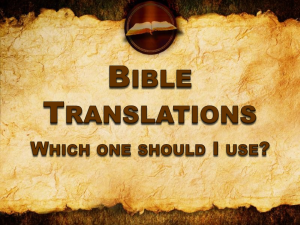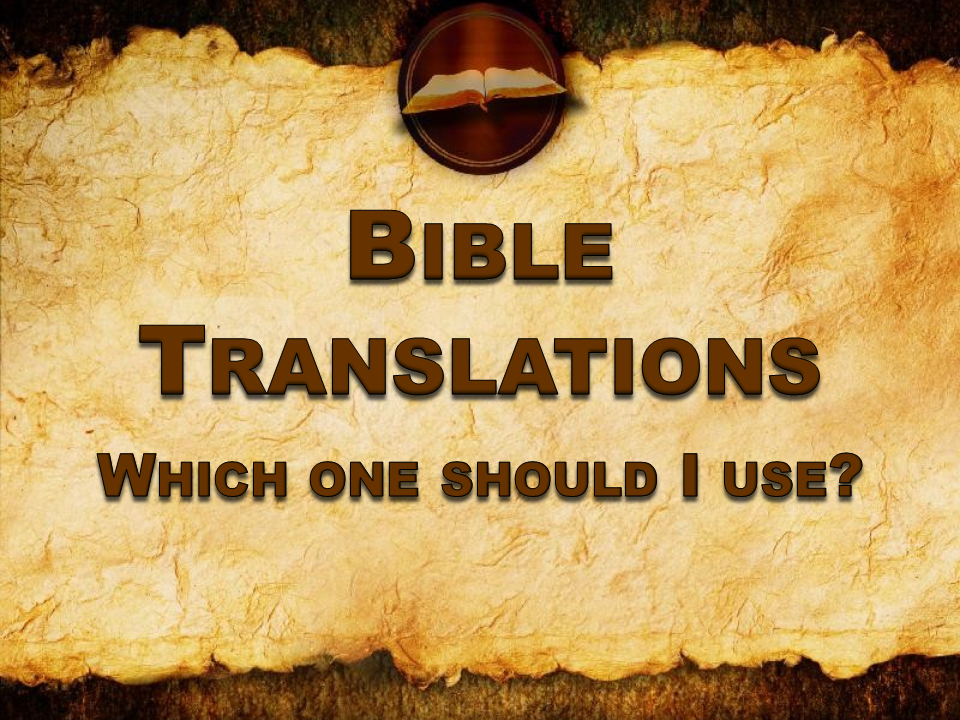Click here to begin at Section 1: History of the Bible
 Now that we’ve covered the issues behind Bible translations, we have come to the big question. How do we choose which one to use? When we’re standing in the bookstore with a sea of initials in front of us, which one do we select?
Now that we’ve covered the issues behind Bible translations, we have come to the big question. How do we choose which one to use? When we’re standing in the bookstore with a sea of initials in front of us, which one do we select?
You may have noticed that most of the Bible version controversy centers around the King James Version. Some proponents of the KJV are adamant in their beliefs because they believe that all other versions tamper with the Word of God. This is a generalization, of course, because many of those who prefer the KJV will accept other translations (such as the NKJV or NASB), while others go so far as to say that the translation of the KJV was inspired and is more reliable that the text from which it was translated. As I have already pointed out, at the heart of this debate for the informed person are the questions of underlying text and translation methods. However, other arguments exist. For example, some claim that because the KJV has been used by God for four hundred years that it proves it is the tool God has chosen to use to declare Himself to English-speaking people. While it is true that God has greatly used this version and all of us who grew up using it have a great appreciation for it, is it possible that God may also permit newer versions to also be used? After all, the KJV was the “new kid on the block” at one time.
The interesting aspect of this debate is that everything that is now old and trusted was at one time new and untrusted. Change is inherently difficult, and proposing a change in Bible version borders on heresy. To illustrate, let’s take a few examples from the history of the Bible. Take note also that the idea of a perfect translation (even to the point of inspired translators) did not originate with followers of the KJV. It has happened many times in the past.
In the third and second centuries before Christ, persecution had resulted in the dispersion of Jews all over the Greek-speaking world. Eventually these Jews began to take on the language and customs of the Greeks, so the Hebrew Scriptures (Old Testament) were translated into Greek. In about 100 B.C., a letter known as the “Letter of Aristeas” was written which claimed that the translators, after working separately, were able to come to agreement.[i] Eventually others took this to mean that the translation process had been miraculous. As the story goes, seventy-two scholars individually translated the books of Moses, and when they met together, they found that each of them had come up with exactly the same translation. As a result, the translation became known as the Septuagint (from the Latin for “seventy”) and it is often referred to as LXX (Roman numerals for seventy). Several famous early church fathers, including Justin Martyr, Irenaeus, and Cyril of Jerusalem, tended to view the Septuagint as the authoritative (and even unalterable) Word of God.[ii]
Problems with the widespread use of the Septuagint began to appear with the rising popularity of Latin. Although the Septuagint had been translated into Latin, Jerome came along and thought it would be beneficial to have Latin Scriptures that were translated directly from the Hebrew. This he did in the fifth century AD. Jerome’s translation, the Vulgate, was not received well by Augustine, the bishop of Hippo. He believed that any place Jerome’s Vulgate differed from the Septuagint, it could not be trusted.[iii] In 405 he wrote a scathing letter to Jerome, berating him for the differences between the Vulgate and the Septuagint (which had been around for 600-700 years).[iv] Augustine believed that the Septuagint had the hand of God on it and was the standard against which other versions should be compared.
Now fast-forward 1,100 years. The popularity of Latin had sidelined the Septuagint and the Vulgate (which also included the New Testament) has become the favorite translation of the masses. In 1546, the Council of Trent deemed the Vulgate to be the “authentic” Scripture and disallowed it from being rejected for any reason.[v] However, some scholars began to feel an urge to re-visit the ancient manuscripts rather than simply trusting a translation (just as Jerome had done all those years before). Among these was Erasmus, who, as we have already seen, began a string of Greek editions of the New Testament that eventually became known as the Textus Receptus. Because his compilations differed from Jerome’s Vulgate, we should not be surprised that he suffered the same blows that Jerome suffered a millennium earlier for daring to “change” the Word of God.[vi] When it comes to change, some things never change.
How should we approach the sensitive subject of Bible translations within our ministries? First, a translation should be as faithful as possible to the original text. While paraphrases and some dynamic equivalent translations can be helpful, they include an overabundance of interpretation on the part of the translators. Second, the translation must be readable. This will, of course, differ depending on the reader. Many of those who grew up with the King James Version may comprehend it with little difficulty. For others, however, the style may become a barrier to understanding. In my opinion, choosing a translation that is closest to formal equivalence that can still be understood is the recommended course of action.
There is no question that God has blessed the ministry of the King James Version, which was originally published in 1611. That is, in fact, one of the reasons that many people believe that the KJV should be the only translation in use. Most people, it seems, grew up with it. Even many who make use of other versions quote from the KJV, because it is engrained in their memory. While there are some that have turned their back in defiance on the KJV, I think most of us love and respect it. Does that mean, however, that newer versions should never be printed?
If you go to the bookstore today and buy a KJV Bible, it will most likely be the edition of 1769. Between 1611 and 1769, many revisions were made. Those who dislike the KJV often point to these revisions as proof that the “1611” was not as perfect as is often cited, while KJV supporters claim that the revisions were minor. The simple fact is that even since 1769, the English language has changed dramatically. For example, the KJV declares that the Word of God is “quick, and powerful” (Hebrews 4:12). In my mind, I automatically envision a sword zooming through the sky all by itself, slashing quickly at its enemies. However, the Greek word behind “quick” means “alive.” The KJV translators were correct in their translation, because “quick” also means “alive.” However, the word “quick” has a far more common meaning that our minds automatically affix to the word. Therefore, modern translations appropriately use the word “living” or “alive.”
Another example, which I am a little hesitant to bring up because it has become so engrained in our thinking, comes from II Timothy 2:15. In the KJV the verse begins with “Study to shew thyself approved unto God…” How do we get approval from God? We study! So we go to AWANA to memorize Scripture. The truth, however, is that Paul was not encouraging Timothy to go to school or read more books. The word he used means to “make haste” or “be diligent,” and is translated with that meaning every other place it appears in the KJV. Again, the KJV translators did not get it wrong. We just no longer use the word “study” in that way. Just to make it clear, going to AWANA is good and memorizing Scripture is one of the best ways to “study to shew thyself approved unto God.” However, Paul’s command encompasses much more than mere study.
We should also take into consideration the fact that words change meaning over time. For example, in the KJV, the term “bastards” appears in Hebrews 12:8. While this word means “illegitimate children,” it has come to be used more as a curse word than a designation for a child born out of wedlock. Therefore, other translations prefer to use “not legitimate” (NIV) or “illegitimate children” (ESV). This is a perfectly acceptable translation of the Greek word nothos and is also suitable for use in our society. Another unsavory word appears in I Samuel 25:22 (and five other places). Look it up in the KJV and see if you would prefer your children to use another word that means exactly the same thing. Another acceptable (and more palatable) way of translating this word would be “urinate.” It was a derogatory term used to describe males, and in most other versions the phrase is simply translated as “males.” And while we’re on the subject, I feel much more comfortable talking about Balaam’s “dumb donkey” (II Peter 2:16) than the “dumb a–” in the KJV. Fewer snickers from the kids that way.
Even the translators of the King James Version of 1611 understood that changes in language require updates to translations of the Bible. In the preface to their translation they instructed the reader that “if anything be halting, or superfluous, or not so agreeable to the original, the same may be corrected, and the truth set in place.”
Which translation should be used depends also on the purpose for which it will be used. A serious scholar will often prefer a literal (formal) translation so he can view all pertinent conjunctions and diagram the sentences.[vii] Others may prefer a more dynamic translation because of the readability factor.
Consider handing a KJV to a person who has no knowledge of the Bible or Christianity. He opens it with anticipation only to find older English words such as “thee” and “thou” and words ending in “eth.” What kind of message are we sending about the Bible? Would he not be tempted to surmise that the Bible is an elite book that is for intellectual people or for those of the past? If the original writers had penned it with this kind of language, then I would be the first to accept it as the way it should be translated. However, the Scriptures were written in such a way that people could understand. Why do we take something easy to understand and make it more difficult?
After studying this whole matter, I came to two conclusions. The first deals with the underlying texts, and the second takes into consideration the methods of translation.
First, I see no problem considering all of the texts that have been discovered. The Textus Receptus is a family of similar manuscripts, not a single document that has been miraculously preserved. Therefore, it is beneficial for all of the available manuscripts to be compared.
Second, because I believe in the verbal inspiration of the Scriptures, I prefer for my English translation to follow as closely to the original language as possible, while keeping its readability. Therefore, when choosing a translation, we should select one that is as literal (formally equivalent) as possible while being translated in a way that we can understand. If you can understand the King James Version without trouble, I recommend it. If you prefer something more readable (and lean toward the Textus Receptus), then try the New King James. Other good formally equivalent translations are the ESV and the NASB. I would caution against making a dynamic translation your Bible of choice, primarily because it places too much dependence on the translator.
Final Thoughts
As I mentioned earlier, I know that the topic of Bible versions is a “hot potato” and one’s view on the subject is often a criterion for fellowship or separation. Nevertheless, it is important for us to know why we believe what we believe.
I also think that the question “Which Bible version do you read?” should be usurped by the more important question “Are you reading your Bible?” Furthermore, “Are you putting to practice what you are reading?” Donald Whitney colorfully records that “some wag remarked that the worst dust storm in history would happen if all church members who were neglecting their Bibles dusted them off simultaneously.”[viii] As far as I’m concerned, if we are not habitually reading and obeying our Bibles, we have no right to debate which version is “correct.”
Click here to download all four sections in PDF
Section 1: History of the Bible
Section 2: Underlying Texts
Section 3: Methods of Translation
Section 4: How to Choose a Translation
Information about specific versions
King James Version (KJV)
Originally translated: 1611
Translation Method: Formal Equivalence
Old Testament Text: Second Rabbinic Bible (Ben-Chayyim)
New Testament Text: Theodore de Beza 1588/89 (in the line which later became known as the Textus Receptus)
English Revised Version
A revision of the KJV, based on differences of Wescott and Hort (1881) and Tregelles (1857).
Originally Translated: 1885 (NT in 1881)Translation Method: Formal Equivalence
Old Testament Text: The Preface indicates that it uses the Masoretic text, only to differ in exceptional cases.
New Testament Text: Revised using Wescott and Hort (1881) and Tregelles (1857)
American Standard Version (ASV)
It was a revision of the English Revised Version of 1885.
Originally translated: 1901
Translation method: Formal Equivalence
Old Testament Text: Masoretic Text with Septuagint influence
New Testament Text: Wescott and Hort (1881), Tregelles (1857)
Note: The Jehovah’s Witnesses used the ASV until the publication of the New World Translation, partly because it translates the name of God as “Jehovah.”
Revised Standard Version (RSV)
Originally Translated: 1952, as a revision of the ASV
Old Testament Text: Masoretic (BHS) with influence from ancient versions
New Testament Text: Nestle-Aland N.T.G. 17th edition
Translation Method: Formal Equivalence
New Revised Standard Version (NRSV)
Originally Translated: 1989
Translation Method: Formal equivalence – the “To the Reader” section indicates that they followed the maxim “As literal as possible, as free as necessary”
Old Testament Text: Biblia Hebraica Stuttgartensia (BHS)
New Testament Text: Greek New Testament published by the United Bible Societies (1966, 3rd ed, revised in 1983)
Pertinent Information: Attempts to use gender-neutral language when possible
New American Standard Bible (NASB)
Originally Translated: 1971, updated 1995
Translation Method: Formal Equivalence
Old Testament Text: Kittel’s Biblica Hebraica with Septuagint and other influence
New Testament Text: Mostly Nestle 26th edition (23rd edition in the 1971 version)
Pertinent Information: The 1995 update removed pronouns such as “thee” and “thou” when referring to God. The NASB is considered to be a very accurate translation. It originally attempted to preserve the literal accuracy of the ASV.
English Standard Version (ESV)
The ESV is a revision of the RSV (1971)
Originally Translated: 2001
Translation Method: Formal Equivalence
Old Testament Text: Biblia Hebraica Stuttgartensia (BHS 1966/1967), influenced by Septuagint
New Testament Text: Nestle-Aland N.T.G. 27th edition
New King James Version (NKJV)
The NKJV was designed to emulate the word flow as well as the spelling of the KJV.
Originally Translated: 1982
Translation Method: Formal Equivalence
Old Testament Text: Biblia Hebraica Stuttgartensia (BHS 1966/1967), comparing Bomberg 1524, the Septuagint, Vulgate, Dead Sea Scrolls. Note that the KJV had to rely on previous versions in some sections where the information was limited. The NKJV translators made use of new findings of the Hebrew text in these places.
New Testament Text: Textus Receptus, with variations based on the Critical or Majority texts indicated in the footnotes
New International Version (NIV)
Originally Translated: 1978, revised 1984, 2011
The TNIV (Today’s New International Version) was published in 2005 (NT in 2002), making use of gender-neutral pronouns. The 2011 revision attempts to bring these two together.
Translation Method: Dynamic Equivalence
Old Testament Text: Biblia Hebraica, with input from the Dead Sea Scrolls and many other ancient texts.
New Testament Text: Eclectic approach but based on the Nestle-Aland Greek New Testament. When readings between texts varied, the translators determined which to use. When the original was unclear, it was indicated in footnotes.
New Living Translation (NLT)
The NLT was designed to be an easy-to read translation that can be easily read aloud.
Translated: 1996, 2004, 2007
Old Testament Text: Biblia Hebraica Stuttgartensia (BHS 1977), comparing other ancient texts
New Testament Text: Greek New Testament (UBS 4th revised edition, 1993) and Novum Testamentum Graece (NA 27th edition, 1993)
Translation Method: Dynamic Equivalence
The Living Bible (TLB)
Translated: 1971
The Living Bible is a rewording of the ASV by Kenneth Taylor.
Translation Method: Paraphrase
The Message
Translated: 1993-2002
The Message is a rendering of Hebrew and Greek by Eugene H. Peterson.
Translation Method: Paraphrase
Notes
[i] Douglas K. Kutilek in Beacham, 29.
[ii] Ibid., 29-34.
[iii] Ibid., 34-35.
[iv] White, 11-12.
[v] Ibid., 38.
[vi] White, 16-17.
[vii] Robert W. Milliman, in Beacham, 148.
[viii] Donald S. Whitney, Spiritual Disciplines for the Christian Life (Colorado Springs: Navpress, 1991, Sixth printing, 1994), 24.



